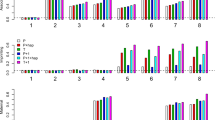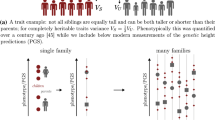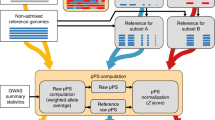Abstract
Busjahn et al1 reported finding linkage between PPARG (3p25) and being a dizygotic (DZ) twin. We differentiate, as do the authors, between the conception of DZ twins, and being the viable result of such a conception.
Similar content being viewed by others
Main
We observe no evidence of linkage to the region around the PPARG locus in several samples of DZ twins who have been genotyped at multiple markers on chromosome 3 (Fig. 1). Among 199 Australian DZ twins ascertained for a history of wheezing2, mean identity by descent (IBD) sharing at the position of PPARG is 0.463 (99% bootstrapped confidence interval=0.412–0.516). We obtained a similar result with 232 pairs of Australian adolescent DZ twins taking part in a longitudinal study of naevus development3 (0.444, 0.390–0.499), and a set of 125 Australian adult DZ twin pairs assessed for anxiety4 (0.508, 0.435–0.580). A Dutch scan of 160 DZ twin pairs5 obtained slightly more encouraging results (0.553, 0.482–0.587, peak maximum lod score (MLS)=0.57). Pooling all these samples gives 0.477 (0.454–0.512) at the position of PPARG. The test for heterogeneity of sharing between studies was not significant (P=0.10). In the combined dataset, the peak IBD sharing (MLS=0.70) is 50 cM closer to the centromere than PPARG.
Finally, in a sample of 203 Australian and New Zealand sister pairs where each had given birth to DZ twins6, sharing across the region is also not increased (0.433). We do not replicate linkage in the populations we study to survival of a twin pregnancy or polyovulation.
References
Busjahn, A. et al. Nature Genet. 26, 398–399 (2000).
Duffy, D. et al. Am. Rev. Respir. Crit. Care Med. 157, 840–845 (1998).
Zhu, G. et al. Am. J. Hum. Genet. 65, 483–492 (1999).
Boomsmsa, D. et al. Twin Res. 3, 323–334 (2000).
Kirk, K. et al. Twin Res. 3, 299–309 (2000).
Montgomery, G. et al. J. Clin. Endocrinol. Metab. 85, 3391–3395 (2000).
Author information
Authors and Affiliations
Rights and permissions
About this article
Cite this article
Duffy, D., Montgomery, G., Treloar, S. et al. IBD sharing around the PPARG locus is not increased in dizygotic twins or their mothers. Nat Genet 28, 315 (2001). https://doi.org/10.1038/91074
Received:
Accepted:
Issue Date:
DOI: https://doi.org/10.1038/91074
This article is cited by
-
Genetic control of multiple births in low ovulating mammalian species
Mammalian Genome (2012)
-
Genome-wide linkage scan for spontaneous DZ twinning
European Journal of Human Genetics (2006)




